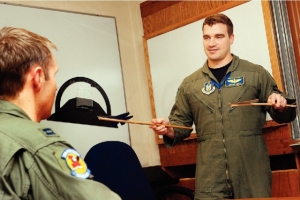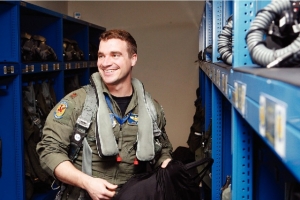Reservists will help train future Air Force pilots, WSOs
By Kenneth Fine
Published in News on February 16, 2009 1:46 PM

News-Argus/MITCH LOEBER
307th Fighter Squadron Maj. Jason Reiss instructs a member of the 334th.

News-Argus/MITCH LOEBER
307th Fighter Squadron Maj. Jason Reiss checks his gear in the life support office before his flight with pilots-in-training from the 334th Fighter Squadron Feb. 10. Reiss is one of the Air Force reservists now attached to the 4th Fighter Wing.
A pilot steps to the Seymour Johnson Air Force Base flight line.
He has an Air Force Reserve patch on his chest, but he is not approaching a KC-135R Strato-tanker.
He isn't even a member of the 916th Air Refueling Wing.
The 4th Fighter Wing now has its own group of Reservists, members of the 307th Fighter Squadron's Detachment 3.
And in many ways, their presence on base is a reflection of where the Air Force is headed, officials said.
307th Commander Lt. Col. Kevin Fesler said 4th Commander Col. Mark Kelly came up with the idea of attaching Reserve air crew to the wing's Strike Eagle training squadrons in 2004.
At the time, Kelly was commander of one of them -- the 333rd Fighter Squadron.
"He saw that the limitation was not necessarily the number of airplanes. It wasn't necessarily maintenance. He didn't have enough instructor aviators," Fesler said. "So he began to socialize the idea of Total Force Integration. He said, 'Why don't we bring in either part-time or full-time Air Force Reserve personnel to augment ... to help us get where we need to be."
Gen. T. Michael Moseley, then Air Force Chief of Staff, agreed.
He decided to create a "classic associate unit" at Seymour Johnson, defined as a scenario in which the Air Force owns the aircraft and the Reserves help fly them.
Air Combat Commander Gen. John Corley talked about such associations last month.
"The Reserve component is, in my mind, no longer solely a strategic Reserve. That's old thinking. The Reserve component is an equal partner and part of an operational Air Force," he said. "The associations have to be there. We are at a period when to accomplish the mission with the level of intensity and demand that is on us, we have to turn to more associations."
There is currently one part-time and four full-time Reservists in the unit, each required to work at least seven days per month.
But Fesler hopes by the end of the year, seven more airmen will fly among them.
And he expects there will be.
After all, the Reserve lifestyle has its perks.
"This is for people who love what they are doing, but they are looking, maybe, to create a little more stability in their family lives," he said. "Now we don't actively recruit active-duty Air Force personnel, but we want folks to know that, hey, if you're considering a career change, we have an opportunity for you here."
The 307th has a history that dates back to its days as an F-4 training squadron based at Homestead Air Force Base, Florida.
Currently, the squadron has four detachments.
Three of them, those housed at Shaw, Eglin and Langely Air Force bases, are operational -- or deployable.
Seymour Johnson's is the newest detachment but for now, will forgo deployments to focus strictly on training future aviators.
